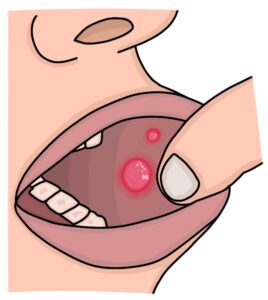Behçet’s disease is a complex inflammatory condition affecting the blood vessels and tissues. The main features are recurrent oral and genital ulcers. It can affect other areas, such as the eyes, skin, gastrointestinal tract, lungs, blood vessels, musculoskeletal system and central nervous system. Symptoms can range from mild to severe.
There is a link with the HLA B51 gene.
Differential Diagnosis
Mouth ulcers are very common and have a long list of possible causes:
- Simple aphthous ulcers are very common without any associated disease
- Squamous cell carcinoma
- Herpes simplex virus
- Hand, foot and mouth disease (coxsackie A virus)
- Inflammatory bowel disease (e.g., Crohn’s disease)
- Coeliac disease
- Connective tissue diseases (e.g., rheumatoid arthritis and systemic lupus erythematosus)
- Vitamin deficiency (e.g., iron, B12, folate and vitamin D)
- HIV
Features
Oral ulcers are expected at least 3 times per year in patients with Behçet’s disease. They are painful, sharply circumscribed erosions with a red halo occurring on the oral mucosa and heal over 2-4 weeks. Genital ulcers are similar in appearance to oral ulcers. Ulcers may leave a scar.

Behçet’s disease can affect many organs in the body, including:
- Skin (e.g., erythema nodosum and papules and pustules similar to acne)
- Eyes (e.g., anterior or posterior uveitis, retinal vasculitis and retinal artery or vein thrombosis)
- Musculoskeletal system (e.g., stiffness, arthralgia and oligoarthritis)
- Gastrointestinal system (e.g., ulceration in the ileum, caecum and ascending colon)
- Central nervous system (e.g., aseptic meningitis and cerebral venous sinus thrombosis)
- Arteries (e.g., aneurysms)
- Veins (e.g., deep vein thrombosis and Budd-Chiari syndrome)
Pathergy Test
The pathergy test involves using a sterile needle to make multiple pricks on the forearm. The area is reviewed 24-48 hours later to look for erythema (redness) and induration (thickening), indicating non-specific skin hypersensitivity. A positive result can indicate Behçet’s disease, Sweet’s syndrome or pyoderma gangrenosum.
Management
Behçet’s disease is a clinical diagnosis. A specialist rheumatologist coordinates management. Other specialities may be involved depending on the affected areas, such as dermatology, ophthalmology and neurology.
Management involves a combination of:
- Topical steroids for mouth ulcers (e.g., soluble betamethasone tablets)
- Systemic steroids (e.g., oral prednisolone)
- Colchicine can be helpful with symptoms
- Topical anaesthetics for genital ulcers (e.g., lidocaine ointment)
- Immunosuppressants (e.g., azathioprine)
- Biologic therapy (e.g., infliximab)
Prognosis
Behçet’s disease takes a relapsing-remitting course. Patients may go into complete remission. Most patients have a normal life expectancy. Major complications include vision loss, ruptured pulmonary aneurysms, bowel perforation and neuro-Behçet’s disease.
Last updated September 2023
